#ParanormalHistory
Explore tagged Tumblr posts
Text
#urbanlegends#hauntedOrphanage#unsolvedmystery#paranormalhistory#forgottentowns#britishhorror#theshadowofhope
0 notes
Text

Step into a world where the line between reality and the supernatural blurs. Emily Garrison was born with extraordinary 'gifts'—the ability to connect with minds and experience visions. But these gifts come at a price. Through her mother Mamie’s eyes, uncover the untold stories of the Garrison family, from the turbulence of Reconstruction to the shadows of Jim Crow. The past has secrets yet to be revealed, and Mamie has so much more to share...
Don’t miss the captivating conclusion to the award-winning The Garrisons series! Read it on Kindle Unlimited. → https://amzn.to/3VxQVkV
@poisedpenpro-blog @poisedpenproductions
0 notes
Text

Did you know that Arthur Conan Doyle, the creator of Sherlock Holmes, was raised as a Roman Catholic but later distanced himself from traditional Christianity. He developed a profound interest in Spiritualism, a belief system that emphasises communication with the spirits of the deceased. Doyle became an ardent proponent of Spiritualism, viewing it as a means to reconcile science and religion. His dedication to these beliefs led him to write extensively on the subject and participate in numerous lectures and debates. 🔎 #SherlockHolmes 🕵️♂️ #DetectiveFiction 📚 #MysteryBooks 📖 #ClassicDetectives 📝 #ArthurConanDoyle 🔍 #Whodunit ✨ #FantasyMystery 🦇 #SupernaturalDetective 🔮 #Spiritualism 👁 #OccultMysteries 🌙 #ParanormalHistory 📜 #GhostStories 📖 #BookLover 🏰 #HistoricalFictionFans 🔥 #Bookstagram 💡 #DidYouKnow 🧠 #LiteraryTrivia
#SherlockHolmes#DetectiveFiction#📚#MysteryBooks#📖#ClassicDetectives#📝#ArthurConanDoyle#🔍#Whodunit#✨#FantasyMystery#🦇#SupernaturalDetective#🔮#Spiritualism#👁#OccultMysteries#🌙#ParanormalHistory#📜#GhostStories#BookLover#🏰#HistoricalFictionFans#🔥#Bookstagram#💡#DidYouKnow#🧠
0 notes
Text
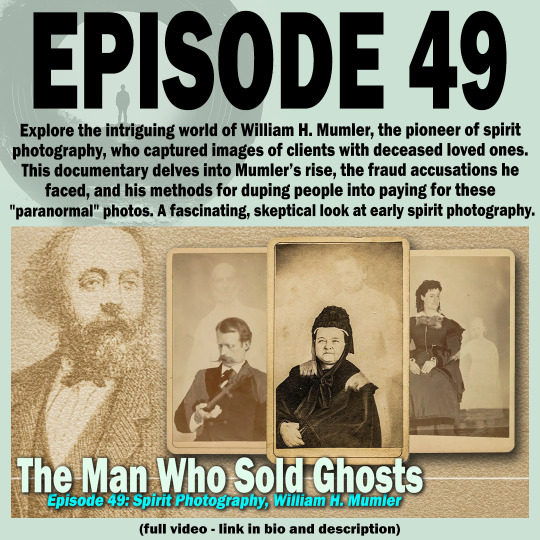
NEW VIDEO: Episode 49 – Spirit Photography, William H. Mumler 👻✨ In the late 19th century, William H. Mumler became a name synonymous with spirit photography—capturing images of the living alongside their deceased loved ones. At a time when people were grieving and searching for signs from beyond, Mumler's photographs promised to connect the living with the spirits of the dead. But was it genuine, or simply a clever scam?
The story of Mumler’s rise to fame and eventual fall from grace is as eerie as the photos he took. In this video, we dive deep into his techniques, the trials he faced when accused of fraud, and how his work sparked both fascination and skepticism. Was he a visionary capturing the supernatural, or a con artist preying on the vulnerable?
Find out the truth behind one of the most controversial figures in photography history. Watch the full video—link in bio!
https://youtu.be/YGV8VXqchVc Please share it with others if you enjoy it. Head over to my YouTube channel to watch.
#SpiritPhotography#WilliamHMumler#FraudOrPhenomenon#HistoricalPhotography#SupernaturalPhotography#GhostPhotos#PhotographyHistory#FamousFrauds#ParanormalHistory#VictorianEraPhotography#Spiritualism#HauntedPhotography#PhotographyDocumentary#PhotographyScams#EeriePhotos#HistoricPhotography#Photodocumentary#MustSeePhotos#asmr#athousandwords
0 notes
Text
Hammersmith: A Haunting, A Hoax, and a Tragic Hunt
The calendar page had barely turned over to the new year and twenty-nine-year-old Francis Smith was experiencing one of the worst times of his life. He sat before the court positively morose for what he had done. On that awful night of January 3rd 1804 he immediately surrendered to the constable, deeply regretting how it all unfolded. Now all he could do was plead for mercy and understanding. After all, at that moment he truly believed he was acting on behalf of the entire borough when he shot the gun.
Over the course of twelve months the West London district of Hammersmith fell into a state of apprehension and deep fear. It all began when a man committed suicide by slashing his own throat and, in a move that went against all rule and beliefs, he was buried in the consecrated ground of the churchyard ensuring that his soul would never find peace. It was after this controversial burial that people began to report seeing a figure, draped in a white shroud, appearing throughout Hammersmith. Surely this had to be the tormented spirit of the man who committed suicide and was then committed to sacred ground. What other explanation could there be? If the incidents remained as ghostly sightings it may have never progressed beyond a simple haunted tale, but the encounters got violent, and then people allegedly began to die. A brewer’s servant named Thomas Broom later told how he was walking through the churchyard with a friend one night when he was suddenly grabbed violently by the throat. It was only when his friend turned to see what happened that he claimed the specter “gave me a twist round, and I saw nothing; I gave a bit of a push out with my fist, and felt something soft, like a great coat.” Another pair of stories alleged that an elderly woman and a pregnant woman both encountered the malevolent spirit on separate occasions near the churchyard and they were both so terrified that when they returned home they could not leave their beds, dying there a few days later.

An image of the Hammersmith Ghost attacking a woman. Image via The Newgate Calendar, Part III (1826), http://www.exclassics.com/newgate/ngconts.htm.
The people of Hammersmith were scared but some were also skeptical, believing this was not a ghost, but a cruel and devious human being. Ghost or human, either way their reign of terror had to be stopped. At this point Hammersmith did not have a formal police force so in order to protect the people some of its own citizens began patrolling the streets after dark. One of these men guarding the night was Francis Smith, armed with a shotgun, and another was night watchman William Girdler. On the night of January 3rd at approximately 10:30pm Girdler ran into Smith and told him that later that night he would meet up with him and they would look for the ghost together. Girdler knew what he was looking for after all, only a few days earlier on December 29thhe saw the ghost and chased him down but the figure disappeared into the darkness.

Engraving of the Hammersmith Ghost appearing in Kirby's Wonderful and Scientific Museum circa 1804. Image via Wikipedia.
Another man walking the streets that night was thirty-two year old bricklayer Thomas Millwood. He was visiting with his sister, mother, and father and as the clock moved closer to 11pm he stood up, said goodnight to his parents, and prepared to head back home for the evening. His sister Anne watched him walk away from the door. She wished he had listened to her and worn something over his work clothes of linen pants, a waistcoat, and an apron. They were recently washed and glowed bright white in the darkness. He had already been mistaken for the notorious Hammersmith Ghost at least twice before but he met any accusation with a scoff.
Within minutes she heard the voice, “Damn you. Who are you and what do you want? I’ll shoot you if you don’t speak.” Then she heard the gunshot.
Anne ran out into the dark and before long she made the horrifying discovery of her brother laying in the road, dead in a pool of blood, with his face mauled by a bullet. She was not alone with her brother, already with his body was nearby wine merchant John Locke, William Girdler, and Francis Smith. What happened spilled out of their mouths and fell into place quickly. Locke heard the gunshot and soon afterwards Smith rushed up to him, severely distressed, and told him he had just shot a man and asked him to go back to the scene with him. After they got back to Millwood’s body they were quickly joined by Girdler and Anne Millwood. When the constable arrived at the scene Smith accepted full responsibility for what happened. He was taken to Newgate Prison to await trial and the body of Thomas Millwood was taken to Black Lion Inn where it was examined by a surgeon who determined that the bullet went through his jaw and hit his spinal cord killing him instantly.
Smith’s trial began one week later and it might have seemed like a fairly straightforward case. He did admit to shooting Millwood, but it was not that simple. Despite taking responsibility for Millwood’s death, Smith entered a plea of Not Guilty based on his account that he felt he was not hunting an actual ghost, but a person acting as a ghost and terrorizing Hammersmith. When he saw the white figure he knew he was facing a man and he called out to him twice, telling him to name himself. When he did not stop or speak Smith said he became fearful for his life because the figure kept approaching him. He shot, but did not aim to kill, it was just an all around unfortunate accident. There were no witnesses to the crime so heavy reliance was placed on the few who arrived at the scene. Locke stated that when Smith met him and asked him to accompany him back to Millwood he was genuinely distraught and horrified at what happened. Several others testified about Smith’s honesty, integrity, and all-around good character. The only voice that spoke of any faults came from Anne Millwood who told the court that Smith shot so quickly after calling out for her brother’s name that there was no way he could have responded in time.

Illustration of the encounter between Smith and Millwood. Image via crimemagazine.com.
Smith had people vouching for him, but the judge Lord Chief Baron Macdonald was hearing none of it. He addressed his jury and plainly explained that there was no gray area here, that it was either murder or it was not. Smith went out into the night carrying a gun which spoke to his intent to harm someone. Millwood was simply walking home when he met his end. In the judge’s eyes this was not self-defense and Millwood was doing nothing to warrant Smith shooting his gun. According to him, it did not matter who Smith intended to hunt down. It also did not matter if Millwood was deliberately dressed as a ghost to scare the residents of Hammersmith, that offence did not deserve being shot. According to the judge no matter how the situation was spun, it occurred because of malice and this was why Smith must be found guilty of murder.
Surprisingly, the jury did not go along with the judge’s advice and when they returned it was with a verdict of guilty, but guilty of manslaughter. This was not accepted by Lord Chief Baron Macdonald and his fellow judges once again reminded the jury that they could not find Smith guilty of manslaughter, because it was not a possible outcome when the choices were either guilty of murder or acquitted of murder. Once again the jury consulted with each other and finding no other option, they returned with their verdict: Francis Smith was guilty of murder.
With the verdict came the sentence. Smith was sentenced to death by hanging followed by dissection the following Monday. Inconsolable, Smith had to be held up and carried from the court.
However, as hard-lined as Lord Chief Baron Macdonald was he was well aware of the public opinion that Smith did not deserve to be sentenced as a cold blooded killer. He added “The case gentlemen shall be referred to His Majesty immediately” to his judgement. This gave Smith one more chance, when a case was brought before the King he had the ultimate power to override and change the sentence. For Smith, those few words from Lord Chief Baron Macdonald saved his life. Before the sun rose the next morning his sentence was reduced to one year imprisonment with hard labor.
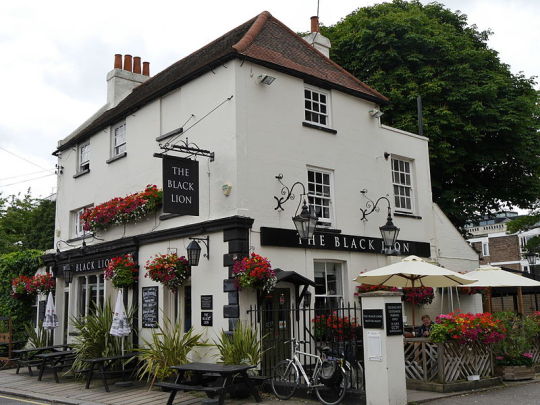
The Black Lion Inn, where Thomas Millwood’s body was taken and where Smith allegedly spent time before the shooting. Image via Wikipedia.
The Hammersmith Ghost, the terrifying being who attacked innocent citizens and was allegedly responsible for suffering, turmoil, and even death, was never heard from again. This is because two days after the death of Thomas Millwood the ghost came forward. A local shoemaker named John Graham admitted that he was the Hammersmith Ghost and that he had been dressing up as the specter to scare his apprentices as an act of revenge because they had been scaring his children with ghost stories. Graham surrendered to the authorities, but because there was no clear legal guidance on this situation he was set free on bail and all traces of him disappeared from record.
Francis Smith was given a full pardon on July 14th 1804.
While the haunting hoax promptly ended, the Hammersmith Ghost trial had far reaching implications when it exposed that there was very little defined in law when it came to people who acted out in a scenario where they believed action was required and carried out under good intentions or when the person acting out misread the situation. Did mistaken belief warrant a criminal charge? Smith was responsible for the death of Millwood, but he believed he was acting against someone who was bringing terror to the people of Hammersmith. The scenario would be brought up in a number of legal cases until it was finally settled in 1983 with the case of Regina v Williams during which the Court of Appeal finally clarified that:
“In a case of self-defence, where self-defence or the prevention of crime is concerned, if the jury came to the conclusion that the defendant believed, or may have believed, that he was being attacked or that a crime was being committed, and that force was necessary to protect himself or to prevent the crime, then the prosecution have not proved their case. If however the defendant’s alleged belief was mistaken and if the mistake was an unreasonable one, that may be a peaceful reason for coming to the conclusion that the belief was not honestly held and should be rejected. Even if the jury come to the conclusion that the mistake was an unreasonable one, if the defendant may genuinely have been labouring under it, he is entitled to rely upon it.”
In 1804 the people of Hammersmith were living in fear of a supernatural entity. This ghost story is still told, but not in front of campfires or on gloomy nights when the veil feels thin. The Hammersmith Ghost died in the same moment as Tom Millwood and today it is carried on not as a spine-chilling story about West London, but as a cautionary tale and a legal precedent that hung over the courts and haunted law practitioners for almost two centuries before it was finally laid to rest.
*******************************************************************************************
Sources:
The Case of the Murdered Ghost
http://news.bbc.co.uk/1/hi/england/london/3364467.stm
The Hammersmith Ghost and the Strange Death of Thomas Millwood by Martin Baggoley http://www.crimemagazine.com/hammersmith-ghost-and-strange-death-thomas-millwood
The Case of a Ghost Haunted England for Over Two Hundred Years by Kelly Buchanan https://blogs.loc.gov/law/2015/10/the-case-of-a-ghost-haunted-england-for-over-two-hundred-years/
The Time Someone Shot A Ghost Dead In Hammersmith by Jane Alexander https://londonist.com/london/features/hammersmith-ghost-story-murder
#husheduphistory#featuredarticles#Britishhistory#LondonHistory#legalhistory#paranormalhistory#ghoststory#famouscourtcases#tragictale#tragichistory#weirdhistory#strangehistory#forgottenhistory#creepyhistory#historyclass#history#oddhistory#truth is stranger than fiction#truestory#hoax#tragicmistake#ghost#courtroom
5 notes
·
View notes
Photo

August 9th 1799, Abner Blaisdel of Machiasport, Maine, first hears knocking noises coming from his cellar. By the following January, the knocking has progressed into a female voice which proclaims, “I’m the dead wife of Captain George Butler, born Nelly Hooper.” The ghost of Nelly Butler became the first documented ghost case in America, and by February was being witnessed regularly by the Blaisdel family and visitors from the surrounding towns, including Nelly’s father. One witness described her appearance as “a mere mass of light. Then it grew into a personal form, about as tall as myself…and the glow from the apparition had a constant tremulous motion. At last, the personal form became shapeless, expanded every way, and then vanished in a moment.” By the end of 1799, she had appeared in front of 100 witnesses, who all swore testimonies to her paranormal existence. Her last appearance took place in July 1806, when she appeared to the Rev. Abraham Cummings, who had disbelieved the sightings, and had discouraged members of his congregation in believing the existence of spirits. Once Nelly Butler had convinced the skeptical preacher, she was heard from no more. Cummings recorded his experiences in “Immortality Proved by the Testimony of Sense : In Which is Contemplated the Doctrine of Spectres and the Existence of a Particular Spectre Addressed to the Candor of this Enlightened Age”, published in 1859. All art shown is for sale on the website: www.ofgraveconcern.com Follow @ofgrave.concern for more gothic tales from history #ghostart #ghoststories #ghoststory #18thcentury #18thcenturyhistory #ghost #ghosting #18thcenturystyle #gothicromance #gothictales #paranormalhistory #ghosthistory #phantasmagoria #paranormalsightings #paranormal #paranormalactivity #mainelife #mainehistory #ghostsighting #ghosting #ghostly #ghostillustration #gothiccandles #gothicillustration #darkillustration #historicalillustration #ghosted https://www.instagram.com/p/CShUvj5H4z6/?utm_medium=tumblr
#ghostart#ghoststories#ghoststory#18thcentury#18thcenturyhistory#ghost#ghosting#18thcenturystyle#gothicromance#gothictales#paranormalhistory#ghosthistory#phantasmagoria#paranormalsightings#paranormal#paranormalactivity#mainelife#mainehistory#ghostsighting#ghostly#ghostillustration#gothiccandles#gothicillustration#darkillustration#historicalillustration#ghosted
0 notes
Text
My Dark Path - Great Podcast
My Dark Path – Great Podcast
When I come across an exceptional podcast that I’m genuinely enjoying, I like to help spread the word about it. My Dark Path is the name of the podcast. It is produced by science fiction author, M.F. Thomas and according to the subtitle on his website the podcast “explores the fringes of history, science, and the paranormal.” Each episode focuses on one portion of history that is little known,…
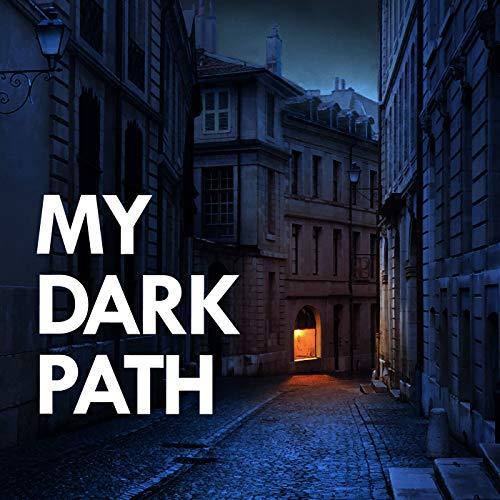
View On WordPress
0 notes
Text
Thomas Wants To Go Home: The Lost Spirit
#paranormalhistory #paranormal #psychometry #hauntedobject #hauntednj #haunted #psychic #ghosthunter #hauntedhistory
Meet Thomas B. Hampton. Thomas doesn’t have a spirit attachment like Lillibet or Ezekiel, but he does have energy—good energy, and he wants to go home. He was referred to me by a past client. “I have a friend who’s looking to get rid of this,” he texted. “You want it?” I clicked on the link. It was a framed poster of a mustachioed man who was running for sheriff of Raritan, NJ, named Thomas B.…

View On WordPress
0 notes
Photo

A Bewitching Tuesday A Round-Up of Daily Tour Stops Author Interview Wicked Darkness by B.L. Callaghan #Fantasy #AuthorInterview #bewitchingbooktours http://ow.ly/NmVb50FO3lc INTERVIEW WITH JENNIFER DEAN (Baited) #bewitchingbooktours http://ow.ly/fn6U50FO3eX Check out this new interview with Roxanne Rhoads at Potions and Paragraphs You'll even get a few teaser details about her upcoming book https://potionsandparagraphs.wordpress.com/2021/08/09/meet-roxanne-rhoads/ #HauntedFlint #GhostsandLegends #TrueCrime #ParanormalHistory #HauntedMichigan #HauntedGeneseeCounty #HauntedLapeerCounty There are Only A Couple Spots Left- Sign Up Now for the 2021 Bewitching Book Tours Haunted Halloween Spooktacular https://bit.ly/3x8HSbD #HalloweenBookPromotion #BookPromotions #BookPromo #AuthorPromo #SignUpsOpen Baited by Jennifer Dean #YAParanormalRomance #YAPNR http://www.roxannerhoads.com/2021/08/baited-by-jennifer-dean.html Baited by Jennifer Dean https://www.lisasworldofbooks.net/2021/baited-by-jennifer-dean
0 notes
Text
It’s a quiet night. The streets are empty, the dim glow of streetlights flickering in the darkness. Then, a soft sobbing sound breaks the silence. You turn and see her—a woman in a long, flowing white dress with disheveled hair covering her face. She stands still, her presence unnatural, as if floating.
#SundelBolong#UrbanLegend#ParanormalHistory#GhostLore#FolkloreFriday#HauntedIndonesia#UnsolvedMystery
0 notes
Text
Little Green Men: The Alien Encounter of Kelly Kentucky
On the night of August 21st 1955 Sheriff Russell Greenwell was working in the police department for the tiny town of Hopkinsville, Kentucky when the night took a sharp turn into bizarre territory. Multiple adults and children stormed into the building highly distressed and saying they needed Greenwell’s help. One of the adults, Billy Ray Taylor, had a racing pulse twice the normal resting rate and the children were completely hysterical. All of them were known in town as very level-headed people. There was no trace of alcohol on anyone and they were a family who took care of themselves, preferring to involve their shotguns rather than the police. What they told Greenwell was that they had spent the last several hours defending their home from attackers, but these attackers were not of this world.
The Sutton Farm was located in nearby Kelly, Kentucky and was the home of Glennie Lankford, her young children Lonnie, Charlton, and Mary, her older sons Elmer "Lucky" Sutton and John Charley "J.C." Sutton, Lucky’s wife Vera, J.C.’s wife Arlene, and Arlene’s brother. Lucky Sutton was home with his family after his last stint with a traveling carnival and his friends Billy Ray Taylor and his wife took the opportunity to stop in and visit everyone. It was a hot Sunday night and at approximately 7pm Billy Ray went to get some water from the well in the backyard when he saw something he could not explain. When he returned to the house he told everyone that he just witnessed a large silver object smoothly traveling through the sky before it went over the house and dropped silently to the ground somewhere in the distance. He was laughed at and the night continued on.
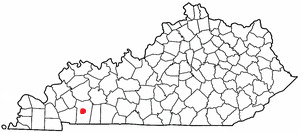
Location of Kelly, Kentucky. Image via wikipedia.org.
The calm did not last long. One hour after Billy Ray’s sighting the Sutton’s dog began to bark incessantly at the back door. When Lucky and Billy Ray went to go see what was going on in the yard they found themselves staring at a glowing light hovering around a three and a half foot tall creature that shimmered like metal with an “oversized head…almost perfectly round, [its] arms extended almost to the ground, [its] hands had talons…and [its oversized] eyes glowed with a yellowish light.”
Frantic and terrified, Billy Ray and Lucky grabbed their shotguns and prepared to fire on the creatures with Glennie and the children watching in bewilderment. Glennie had lived on the property for decades without incident but the commotion coming from the two men concerned her and she sent her younger children to bed before they could get too upset over the outlandish claims coming from Billy Ray and Lucky. Was it a prank? She pressed the two for an explanation but there wasn’t time for any answers. A small glowing figure began to approach the house and for the first time that night shots rang out. The creature raised its arms and did a “flip” before disappearing into the darkness. It was only the beginning of their night.
According to the Sutton family and friends, over the next few hours they found themselves under attack from the little creatures that they could not explain. While hiding inside the home one pressed its face against a window and again flipped out of sight totally unfazed when bullets took out the screen. In a later interview Glennie recalled hiding in a hallway with Billy Ray when they saw one of the beings approaching the back door. She was overcome with shock and fell backwards before her sons carried her into a bedroom. She later stated that “It looked like a five-gallon gasoline can with a head on top and small legs. It was a shimmering bright metal like on my refrigerator.” At one point during the night Billy Ray stepped outside onto a porch where his head was covered by a small overhanging roof. By now the entire family was on alert and they were horrified to see what they described as a claw-like hand reaching down from the roof to grab Billy Ray’s hair from above. The screams cut through the night and Billy Ray was pulled back inside while Lucky ran out and began shooting toward the roof. More than one person reported seeing another small glowing creature jump down and charge into the woods.
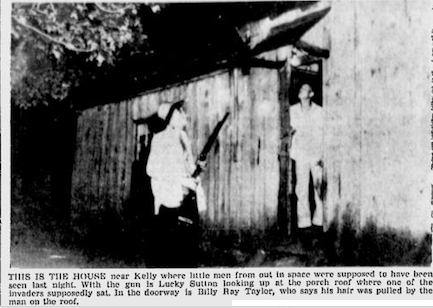
Newspaper article showing the roof where one of the creatures reached for Billy Ray Taylor. Image via https://www.kentuckynewera.com/
For several hours the entire group remained huddled in the house listening to something scratching on the roof and waiting for the unimaginable. Finally, at approximately 11pm they all ran outside, leapt into their cars, and raced to the Hopkinsville police department.
As outlandish as their story sounded, Sheriff Greenwell could not ignore what he was hearing and he decided to go investigate. But, he was not going alone. When the team arrived back at the Sutton farm it included Greenwell, the state police, members of the military police from nearby Fort Campbell, and a photographer from the Kentucky New Era. While searching the premises they found casings from Billy Ray and Lucky’s guns but absolutely no other evidence to suggest anything had happened on the farm that night. Each family member was interviewed individually but all the stories were consistent. With nothing to go on they finally left the site with the family hesitantly returning inside the house. They were not inside long. Before dawn they were all back in their cars, fleeing the house after the creatures came back, appearing in Glennie’s bedroom window and clawing at the screen.
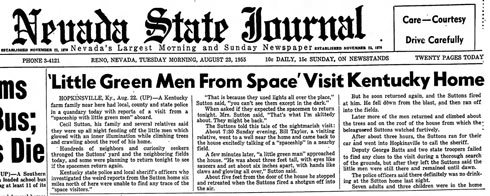
Newspaper article from the Nevada State Journal. Image via Skeptic.com.
When the Suttons returned to their farmhouse they arrived to a chaotic scene. The news of their encounter was spread all over the nation by radio hosts telling their stories and newspapers printing their words alongside shocking illustrations of the “little men” that came out of the sky that night. Curiosity seekers flocked to the farmhouse to investigate the scene for themselves and, in some cases, to take souvenirs. Unfortunately, some also arrived armed with accusations, claiming the family completely fabricated the entire encounter for publicity. The Suttons denied the claims but they did not help their case when they took down their “No Trespassing” signs and replaced them with a price list for admission to the property, information, and photographs. The adult members of the family were again interviewed separately by local radio personality and professional sketch artist Andrew "Bud" Ledwith and every account was the same. They all swore that they were attacked by creatures that stood just under three feet tall, glowed a shimmering metallic green, floated above the ground, and had pointed ears and claws. Tired of being harassed and spied on the family quickly stopped speaking to the media, left the property, and attempted to move on with their lives. Some reports state that after living in the country her entire life Glennie moved into an apartment building to be surrounded by people, she no longer felt safe in isolation.
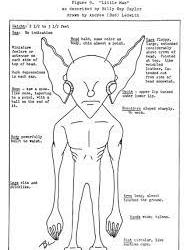
Illustration of the creatures as described by Billy Ray Taylor. Image via history.com.
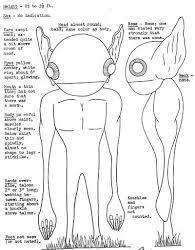
Illustration of the creatures as described by Lucky Sutton. Image via history.com.
With no concrete answers as to what haunted the Sutton family and their friends that night the floor was open for theories to fly. Despite Glennie and her sons insisting alcohol was not allowed in the house many said the entire incident was nothing more than a drunken hallucination. Others believed these little silver men were actually a pack of great horned owls which were known to act aggressively toward people. Some even claimed the creatures were monkeys that Lucky and Billy Ray brought home with them from their stint in the carnival.

Great horned owl at night. Image via Youtube.com.
In 1956 ufologist Isabel Davis began an investigation into what became known as the “Kelly–Hopkinsville Encounter”, an investigation that would result in a nearly 200 page report for the Center for UFO Studies. It was far from alone, as the years moved on many other ufologists became fascinated with the event and their varied explanation and opinions did little to pinpoint what happened that August night. The Air Force UFO-investigation program Project Blue Book was aware of the case but no documentation indicates that they officially pursued it. Project Blue Book’s civil investigator (and founder of the Center for UFO Studies) Dr. J. Allen Hynek called the ordeal "preposterous" and offensive to "common sense.” Ufologist Jerome Clark writes about the possible logical explanations, but also admits there was no evidence of a hoax. Some adopted the tale as solid truth, others became staunch supporters of the owl theory, but with every theory and re-visitation the Kelly–Hopkinsville encounter grew in notoriety. With newspapers focusing on the green metallic glow the world was given a term still familiar today, “little green men.”
In 2005 a commemorative event was held to celebrate the fiftieth anniversary of the Kelly-Hopkinsville Encounter and there was a very special guest in attendance. Geraldine Stith, the granddaughter of Glennie Lankford and daughter of Lucky Sutton was there to answer the questions and dispel the rumors. She stated “I thought, I heard it from the horse's mouth, if people want to hear the story, let's get it right.” In 2010 when the town of Kelly was looking for fundraising opportunities they focused on the alleged alien encounter and created an annual event, the Little Green Men Days Festival that still takes place every August. Stith is a guest every year, telling the tale of her family’s terrifying night of the unknown and listening to stories from others. Despite the festive atmosphere structured around the encounter, Stith does not want what her family endured to be lost stating “My family went through something, whether it be paranormal or extraterrestrial, that changed their lives forever. I just want people to realize the terror they went through that night.”
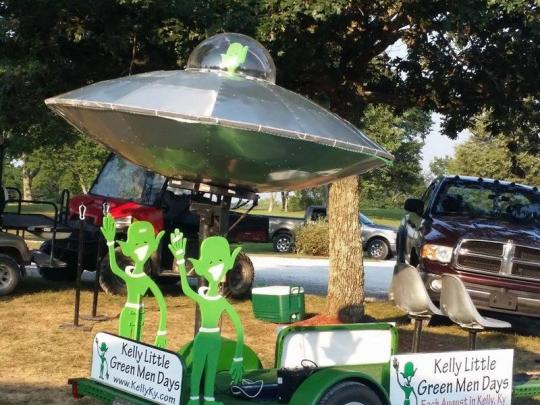
A scene from Little Green Men Days Festival. Image via wkms.org.
Despite countless studies, theories, books, interviews, and experiences, the answer to what haunted the Sutton family and friends that night in August has never been found.
********************
Sources:
“How the 'Little Green Men' Phenomenon Began on a Kentucky Farm” https://www.history.com/news/little-green-men-origins-aliens-hopkinsville-kelly
“The Eerie Story Behind the Small Town Everyone Is Flocking to for the Eclipse This Summer“ https://www.countryliving.com/life/a44064/eclipseville-hopkinsville-ky-history/
“Steven Spielberg, Some Green Men, and Hopkinsville“ https://kyforky.com/blogs/journal/steven-spielberg-some-green-men-and-hopkinsville
“Tales from the path of totality: 62 years ago today, they say, ‘little green men’ invaded this Kentucky farm town” https://www.washingtonpost.com/news/morning-mix/wp/2017/08/21/tales-from-the-path-of-totality-62-years-ago-today-they-say-little-green-men-invaded-this-kentucky-farm-town/
#HushedUpHistory#History#Kentucky#KentuckyHistory#Alienencounter#Unexplained#UnexplainedHistory#Paranormal#ParanormalHistory#ScaryHistory#WeridHistory#ForgottenHistory#StrangeHistory#HorrorHistory#UFO#LittleGreenMen#Truestory#scarystory#truehorror#truthisstrangerthanfiction#unidentified flying object#aliens#alieninvasion#featuredarticles#Unsolved
39 notes
·
View notes
Photo
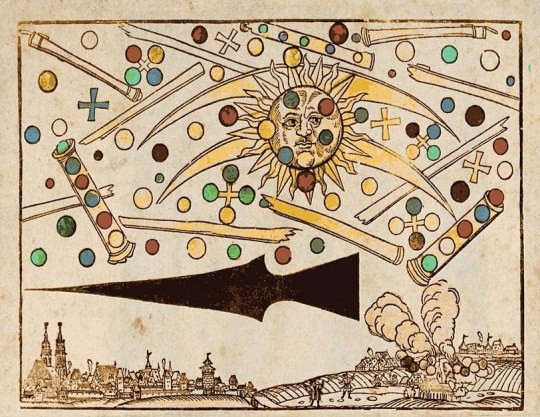
28th July 1566, first sightings of black celestial spheres are recorded in the sky battling one another over Basel, Switzerland. Recorded in a pamphlet printed this same year, the event is described as occurring on the ‘27 and 28 of July, and on August 7, against the sunrise and sunset; we saw strange shapes in the sky.’ Further stating of the sun that is ‘took a different shape and color. First, the sun lost all its radiance and luster, and it was no bigger than the full moon, and finally it seemed to weep tears of blood and the air behind him went dark:’. On the 7th of August the black spheres appeared to be battling one another until they turned a fire red and crumbled. A similar event was also reported in April 1561 in Nuremberg Germany, with the accounts mirroring each other with the sighting of a celestial battle of black shapes, with the sun turning to blood. Follow @ofgrave.concern for more tales of strange history. #ufohistory #baselswitzerland #nuremberg #weirdhistory #paranormalhistory #shapesinthesky #ufoencounters #ufosighting #ufo #ufoart #ufoartwork #history #historic #historical #historylover #historylovers #historygeek #ufostyle #historyart #weirdhistory #strange #strangeevents #1561 #ufos #onthisday #otd #onthisdayinhistory #apocalypse #celestial #portent https://www.instagram.com/p/CR9RKVenWQB/?utm_medium=tumblr
#ufohistory#baselswitzerland#nuremberg#weirdhistory#paranormalhistory#shapesinthesky#ufoencounters#ufosighting#ufo#ufoart#ufoartwork#history#historic#historical#historylover#historylovers#historygeek#ufostyle#historyart#strange#strangeevents#1561#ufos#onthisday#otd#onthisdayinhistory#apocalypse#celestial#portent
0 notes
Text
Maynooth’s Demon, Denial, and the Horror of Rhetoric House
In the 1840s much of Ireland was looking to God and begging for answers. Political turmoil and religious conflict collided with the Great Irish Potato Famine bringing immense suffering to the Irish people who seemed to be losing everything and everyone around them. To many young men, the priesthood could promise many positive things during a time of crushing uncertainty like a connection to divinity, the opportunity to help heal the suffering all over the land, and the ability to serve in their spiritual beliefs. For some, it was a way to guarantee a roof over their head and a meal on their plates. Laying just outside of Dublin is Maynooth’s St. Patrick’s College, the training grounds for Ireland’s Roman Catholic priests since 1795. The school was operating less than a century when it was allegedly marked with unexplained horror.
**********************************************************
Read the rest of the story in Hushed Up History Volume I, available now through Barnes and Noble and Amazon.com!
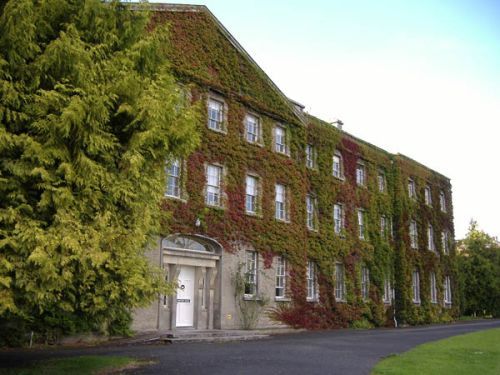
The outside of Rhetoric House at Maynooth (formerly known as Junior House). Image via comeheretome.com.
#HushedUpHistory#featuredarticles#Ireland#IrishHistory#paranormal#paranormalhistory#Maynooth#unexplained#historicbuildings#historicschool#scarystory#scaryhistory#creepyhistory#forgottnehistory#weirdhistory#horrorhistory#historyisnotboring#demonichistory#unsolved#mystery#coverup#creepy#whathappenedhere#haunted#HauntedIreland#Irishhaunting#terrifyingstory#stillthere#history#historyclass
7 notes
·
View notes
Text
Calling the Unknown by Name: Helen Peters Nosworthy and the Naming of the Ouija
There are few objects that pull reactions from people as widespread, varied, and strong as the Ouija board. Since its official arrival in 1890 the lightweight board has been a symbol of horror, intrigue, mystery, wonder, and the source of countless stories from both seasoned paranormal professionals and the bravely curious. Although it is the subject of many questions, one of the most common queries about the board is also the most basic: where did the name “Ouija” come from?
In 1848 Spiritualism began to rage through America, heavily fueled by the claims of the Fox sisters of upstate New York who said they could communicate with the deceased through audible knocks in response to questions. Spiritualism was easily embraced. It did not go against any religious beliefs, it could be practiced in a variety of ways, and it made a desperately needed promise in the United States, the ability to communicate with the deceased at a time when death seemed to be constantly peering around every corner. With a life expectancy of less than sixty years, disease, and the Civil War ripping hundreds of thousands of souls from their families with no explanation or closure, the need to speak to the dead was high, but the results were not fast. Seances and waiting for knocks could be extremely time consuming and in an age newly acquainted with devices like the telegraph there was a deep desire for a faster way to receive messages from beyond the veil.

Image of a séance circa late 1800s.
In 1886 the Associated Press began reporting on an answer to this slow Spiritualism problem, a board with letters, numbers, and a pointer that spelled out messages. Surprisingly, it took several years before someone saw the immense financial possibilities of producing these types of boards and the first to do so was Charles Kennard. In 1890 Kennard teamed up with four friends and formed the Kennard Novelty Company, exclusively dedicated to producing the new talking boards. There were some components missing from the new endeavor, for one, none of the four men had a connection to Spiritualism, but the bigger problem was that their device had no name. Fortunately, they did have a connection to someone who could help them with both.
It is a popular story that the name “Ouija” came from combining “Oui” and “Ja”, the French and German words for “yes” but the true origin of the name comes from Helen Peters Nosworthy. At the time of the board’s invention Helen Peters was sister-in-law to Elijah Bond, one of the four friends of Charles Kennard that helped bring the talking boards to the public. She was a stockholder in the company but she was also considered a “strong Medium” and when the discussion came up about what to call the talking boards Peters did the polite thing, she decided to ask the board itself. When she asked it what it wanted to be called the planchette moved to spell out O-U-I-J-A. When she asked the board what it meant the answer was “Good Luck.”

An original 1891 Ouija board. Image via Wikimedia Commons.
Now that the board had a name it needed to be patented but there was a problem, the patent office refused to issue a patent unless it could be proven that the board actually worked. On February 10th 1891 Peters and Bond arrived at the patent office in Washington D.C., but they were met with nothing but resistance. After being shuffled from one person to another with no luck the chief patent officer decided to see them, but there was a heavy stipulation at hand. The officer said he would only issue the patent if the board could spell his last name. Peters, Bond, and the officer had never met before but according to letters and patent file records, the board did exactly what was asked and spelled the last name. The visibly shaken officer quickly said “you’ve got your patent” as he left the room.

Reprint of the original patent of the Ouija board.
The popularity and sales of the Ouija Board were sky high and within only one year the Kennard Novelty Company expanded from one to seven factories producing the boards. The boards were wildly successful, but they soon became the source of turmoil for some of the people who brought them to life.
Peters came from a family that was deeply rooted in the South with many ties to the Confederate Army during the Civil War. According to family lore, Helen and her siblings went out to a battlefield after a conflict and collected buttons off the dead soldier’s uniforms. The buttons were treasured but one day they went missing. When the board was consulted about the whereabouts of the buttons it named a member of their own family. Half believed the board, the other half including Peters said the board was wrong, and an irreparable hole was ripped through the family. A distraught Peters disavowed the Ouija board, telling everyone to avoid it because it “told lies.” A year after the board’s release she married Shakespearean actor-turned-salesman Ernest Nosworthy and the pair settled in Denver, Colorado until her death in 1940.
Since its arrival the Ouija board has enjoyed the kind of long term success that any inventor dreams of but if not for Robert Murch the name of Helen Peters Nosworthy may have remained lost. Murch is the founder, Chairman of the Board, and President of the Talking Board Historical Society (founded in 2013).
Not long after the launch of the Ouija board ownership of the company switched hands and the grievances of Charles Kennard and Elijah Bond were publicly displayed within the pages of the Baltimore Sun. When Murch was digging into the archives of the newspaper he found the bitter printed letters between Kennard and Bond that spoke about Peters, her trip to the patent office with Bond, and how she asked the board its name, officially making Helen Peters Nosworthy the woman who named the fabled, iconic, and ever-controversial Ouija board.
With the discovery of who named the Ouija board the Talking Board Historical Society began working with her descendants to formally commemorate the woman who became known as “The Mother of the Ouija Board.” On September 22nd 2018 the Talking Board Historical Society, the mayor of Denver, the president of the Fairmount Heritage Foundation, descendants, and the eager public gathered at the gravesite of Helen Peters Nosworthy in Denver’s Fairmount Cemetery to dedicate a memorial in her honor.

The new tombstone of Helen Peters Nosworthy. Image via burialsandbeyond.com.
The image of the classic Ouija board is instantly recognizable, but the visage of the woman who named the icon is far less known. One of the few images we have mirrors the same ethereal quality of any late 1800s story of talking boards and ghosts. In a sketch drawn by her husband while staying at the Hotel Gladstone in Norfolk, Virginia Helen gazes off the page with transfixing eyes and a slight grin. This is the only known image of Helen showing her in the same timeframe when asked the question that would change her life and the world of the paranormal.
“What do you want to be called?”
“O-U-I-J-A”

Sketch of Helen Peters Nosworthy in approximately 1891. Image via burialsandbeyond.com
Sources:
Murch, Robert. "HELEN PETERS NOSWORTHY’S GRAVESTONE." https://robertmurch.com/moreinfo/helen-peters-nosworthys-gravestone/.
McRobbie, Linda R. "The Strange and Mysterious History of the Ouija Board." Smithsonian.com. Last modified October 27, 2013. https://www.smithsonianmag.com/history/the-strange-and-mysterious-history-of-the-ouija-board-5860627/.
"HELEN PETERS NOSWORTHY." The Talking Board Historical Society. https://tbhs.org/helen-peters-nosworthy/.
"Helen Peters Nosworthy: The Medium Behind ‘Ouija’." Burialsandbeyond.com. https://burialsandbeyond.com/2019/01/07/helen-peters-nosworthy-the-medium-behind-ouija/.
#husheduphistory#featured articles#ouijaboard#ouija#paranormalhistory#paranormal#weirdhistory#forgottenhistory#strangehistory#unknownhistory#talkingboard#spiritualism#famousinventions#paranormalwomen#womenintheparanormal#whatsinaname#historyclass#historyisnotborning#truthisstrangerthanfiction#occult#occultitem#infamous#famousgames#knowhername#history#truestory#weirdstory#strangestory
3 notes
·
View notes
Text
Dedicated to Death: The End Experiment of Thomas Bradford
When the Fox sisters of Hydesville, New York claimed they contacted the spirit of a murdered peddler in 1848 the ears of the entire country listened. Suddenly there was hope that those who passed away were not truly gone and people from all over began to scramble to find ways to communicate with the dead. Later, with the horrors of the Civil War tearing the country and families apart people looked to Spiritualism and any way possible to find answers from beyond. Hundreds of thousands never came home, countless numbers were never found and the need for closure and communication drove people into the parlors and palms of people claiming they could be their much-needed bridge to the other side. As many people that believed in life after death, there were just as many who refuted it and the divide grew. As time moved on the division deepened with both sides seeking the ultimate proof that death was, or was not, the end. It is an argument that is still actively debated to this day.
Prof. Thomas Lynn Bradford was a man of many ventures. A one-time electrical engineer, athlete, and actor, by 1920 he had begun studying and lecturing about the occult with a particular focus on the afterlife. The world had now suffered through World War I and people’s spirituality was again feeling highly tested. Bradford was a man of sound mind, but his headspace became more and more filled with his thoughts on life after death and how to prove it. He wrote “…all phenomena are outside the domain of the supernatural." He wanted to prove his theories using scientific fact, but he knew he could not do it alone.
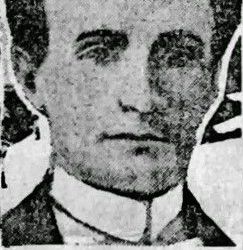
Professor Thomas Lynn Bradford.
In the early part of 1921 Bradford placed an ad in a local Detroit newspaper under the name “Professor Flynn” and stated that he was seeking “someone interested in spiritualistic science.” It was a strange ad, which was exactly why it caught the attention of prominent Detroit native Ruth Starkweather Doran. Doran was not a firm believer in Spiritualism. But, she was an avid researcher and was intrigued with the opportunity to learn about a field so unfamiliar to her. On a whim, she responded to the ad and before long she and Bradford began meeting face to face.
The experiment Bradford presented to Doran would have sent most people running, but for reasons unknown, she stuck with the plan. Before their last meeting on February 5th 1921 Bradford finished typing his latest manuscript and laid it neatly next to his typewriter. There was much to do and once Doran arrived the details were ironed out about how he would contact her when his half of the experiment was complete and how they would then reunite. The deal was made. They bid each other farewell and Bradford shut the door of his rented room. He knew he would not be disturbed, he already informed his landlord, a Mr. Marcotte, that if anyone were to call for him to tell them he was out and would not be back until very late. He turned on his heater. blew out the pilot light, turned up the gas, and laid down in bed until the fumes took his life.
The fact that Bradford killed himself in pursuit of answers about life after death may not have come as a shock to some of his friends. It was later reported that the occult interested him more than anything in the physical world. At one point he told Mr. Marcotte, “When I die my body goes to science. It is to be sent to the Michigan Medical Institute. Anyhow, my body does not amount to much.”
When Bradford’s body was discovered by Marcotte the next day the gas was still pouring from his heater. Upon investigation police found his typewriter, with one final note never removed, “And it is through scientific facts that I propose to demonstrate clearly the phenomena of spirits and prove that all the phenomena is outside the domain of super-natural.” Baffled by the suicide, the Detroit Police Department began to look for an explanation, and the dots quickly led to Doran who escaped any legal action by claiming they had met and discussed proving the afterlife but that she did not know he was planning to kill himself that night. Now, with his lifeless body laying in his home the first part of Bradford’s plan was complete. The second part relied on reconnecting with Doran to prove there was life after death. The self-proclaimed skeptic agreed to go through with it. “I am his friend.” Doran said, “If he can cause his spirit to come back to earth I believe his spirit will come to me first.”

Newspaper headline about Bradford’s suicide.
In the days following Bradford’s suicide the eyes of the Spiritualism world were firmly fixed on Doran’s parlor where she was hosting multiple vigils waiting for her friend to reach out and make contact. Throughout the entire process though, Doran made it a point that she was not a psychic, saying that she was simply a human being there to serve as a middleman and prove Bradford’s theories. She and the intrigued masses patiently waited night after night for a connection, but the hours moved on quietly with Doran only stating at one point that she felt a “strange sensation”.
Doran and the spiritualists were not the only one wanting to hear from Bradford. Multiple newspapers waited eagerly for word, running headlines updating the masses with the New York Times reporting, “Dead Spiritualist Silent” two days after the suicide. It was a few days into a planned two week long vigil that there was finally something to report, but it was not from Doran. A woman named Lulu Mack came forward stating that during a visit with a medium she heard a voice calling the name “Thomas Bradford”, a name she claimed was totally unfamiliar to her at the time. She told reporters that Bradford could not communicate very well because his suicide made him weak, suspending him before he could fully pass on to the next realm. “Life has fled from the body of Thomas Lynn Bradford but his spirit is hovering near and calling to us to hear its message,” Mack reported. “I have heard the call of his spirit. It is calling to me even now. But I cannot hear the message it would send, because the spirit is too weak.”

Headline from The New York Times, February 18, 1921.

Headline from The Pittsburgh Press, February 10, 1921.
Suddenly, a week after Bradford took his own life, Doran claimed she had a feeling she was going to hear from him, but it would be difficult considering how weak he was. Papers, thirsty for the next part of their bizarre story, urged spiritualists to concentrate on Bradford and “assist” him in reaching out. To make sure it was a focused effort it was agreed that 9pm was the time to take action and focus to help Bradford and Doran reconnect.
Much to the delight of some and criticism of others, at 9pm that night Doran sat in her darkened parlor with three witnesses. Suddenly, she put her hands to her temples, commanded the lights be turned off, and told someone to start writing. According to her, Bradford had finally arrived. “I hear his voice” she said to the room, “It is faint, but it grows more distinct. It is the professor.”
As Doran spoke in broken fragments the alleged message from Bradford was slowly pieced together:
“I am the professor who speaks to you from the Beyond. I have broken through the veil. The help of the living has greatly assisted me. I simply went to sleep. I woke up and at first did not realize that I had passed on. I find no great change apparent. I expected things to be much different. They are not. Human forms are retained in outline but not in the physical. I have not traveled far. I am still much in the darkness. I see many people. They appear natural. There is a lightness of responsibility here unlike in life. One feels full of rapture and happiness. Persons of like natures associate. I am associated with other investigators. I do not repent my act. My present plane is but the first series. I am still investigating the future planes regarding which we in this plane are as ignorant as are earthly beings of the life just beyond human life.”
At 10pm the lights were brought back on and a flustered Doran looked over the bits and pieces that she claimed were given to her directly from the spirit of Bradford. Then, she suddenly fainted. Once resuscitated one of the witnesses asked her if she was positive about her message, was she absolutely sure she was speaking with Bradford from beyond the grave? She was adamant, “I am convinced. I never heard a spirit voice before. That was the professor, without doubt."

Illustration from The Ogden Standard-Examiner, February 21, 1921.
For all of the speculation and attention leading up to Doran waiting to hear from Bradford, the aftermath was remarkably tame. Despite the accounts from both Doran and Mack, members of both the Spiritualism community and the general public were not convinced that the alleged message from Bradford was proof of anything. The headlines faded into obscurity and Doran went along with them. Later in the year Doran wrote an article claiming that she maintained regular communication with her departed friend ever since. She was now a believer, still receiving messages from Bradford detailing how one day both realms would meet.
“Through spiritualism the world will be reclaimed: sin will be vanquished, suffering will end” she claimed he told her. “The physical in man will cease to be, and physical death, and that is the only death, will be no more. Men will live on earth forever, even as they live forever in the spirit world.”
At the time of his death Bradford was near penniless. His estranged wife living in Wisconsin only learned of his death later and his body was claimed by a brother, James Bradford, who handed it over to an undertaker for interment.
The body of Professor Thomas Lynn Bradford, the man who gave up his life to prove life after death, is buried in the Mt. Olivet Cemetery in Detroit, Michigan.
#HushedUpHistory#history#DetroitHistory#MichiganHistory#Detroit#Michigan#Spiritualism#Skeptic#ParanormalHistory#Paranormal#Study#Experiment#LifeAfterDeath#SinisterPlan#NotAGoodPlan#Unfortunate#TragicTale#Mediums#Psychic#Talktothedead#FromBeyond#BeyondTheGrave#Spiritualist#weirdhistory#forgottenhistory#tragichistory#sadhistory#creepyhistory#truestory#truthisstrangerthanfiction
7 notes
·
View notes
Photo

#halloween2020 #halloween #halloweenhistory #halloweenart #halloweenartist #weirdhistory #darkhistory #strangehistory #paranormal #paranormalhistory #werewolf #werewolfart #werewolves #execution #16thcentury #dark #werewolfofbedburg #peterstubbe #devil #cryptid #cryptids #cryptidart #macabre #macabreart #macabreartist #gothichistory #gothicliterature #otd #onthisdayinhistory https://www.instagram.com/p/CHAontvA9mH/?igshid=1c5rym6jui5v1
#halloween2020#halloween#halloweenhistory#halloweenart#halloweenartist#weirdhistory#darkhistory#strangehistory#paranormal#paranormalhistory#werewolf#werewolfart#werewolves#execution#16thcentury#dark#werewolfofbedburg#peterstubbe#devil#cryptid#cryptids#cryptidart#macabre#macabreart#macabreartist#gothichistory#gothicliterature#otd#onthisdayinhistory
0 notes